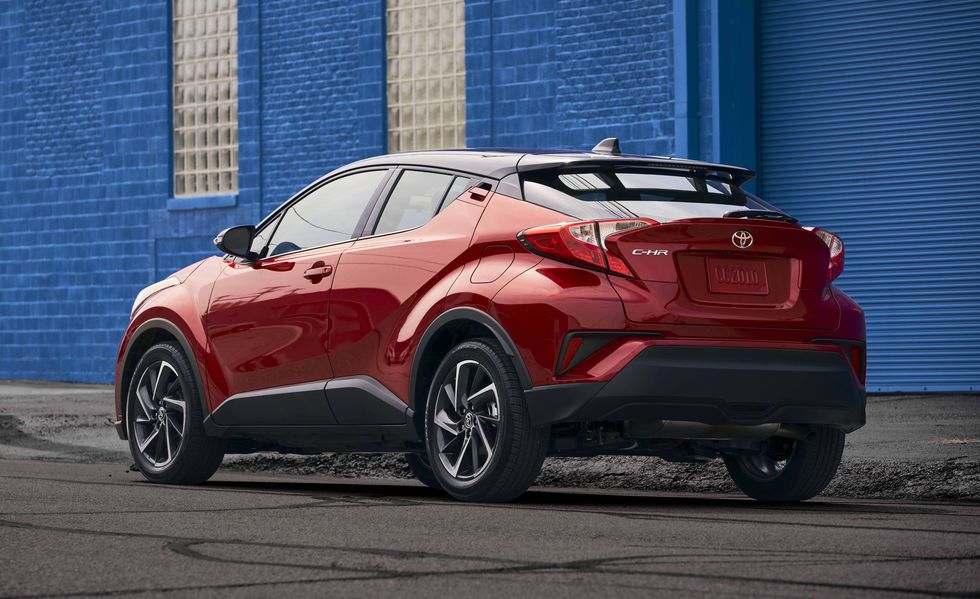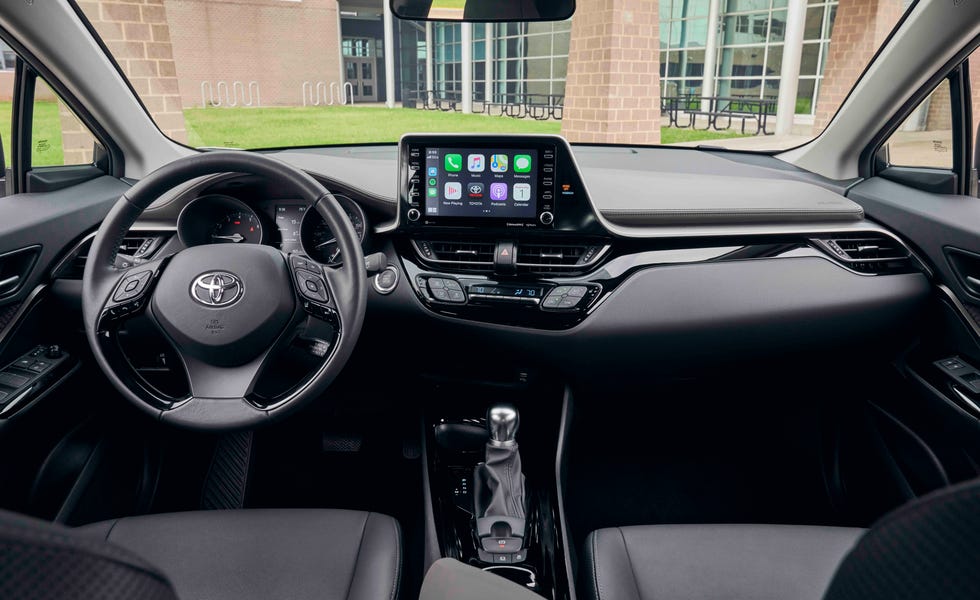2022 Toyota C-HR Review, Pricing, and Specs
Mục Lục
Overview
The 2022 Toyota C-HR’s design is brimming with personality and curb appeal, but its driving demeanor is as bland as it comes. All models come with a lethargic four-cylinder engine, a continuously variable automatic transmission (CVT), and front-wheel drive; all-wheel drive isn’t an option. Acceleration is torturously slow, and although it doesn’t provide a lick of fun on a twisty road, the C-HR’s ride is at least fairly comfortable. The cabin is snug in the rear seat, but otherwise is fairly practical. Some of the C-HR’s cheeky exterior design elements even make their way into the cabin, with an asymmetrical dashboard design, shiny black trim, and textured headliner.
What’s New for 2022?
Toyota has eliminated the affordable base LE trim for 2022, leaving the XLE as the entry-point to the lineup. Wind Chill Pearl replaces Blizzard Pearl on the color palette this year and can be had with a black contrast roof color. Toyota has announced that the C-HR will not return for the 2023 model year, so if you’re into this funky crossover the 2022 model is your last chance.
Pricing and Which One to Buy
The XLE comes with plenty of features that most buyers will consider essential, including 18-inch wheels, a proximity key with passive entry, blind-spot monitoring, heated exterior mirrors, and a leather-wrapped steering wheel. Toyota offers few options other than accessories, but we’d stop there anyway to keep the C-HR’s cost affordable.
Engine, Transmission, and Performance
The C-HR’s four-cylinder could use a turbocharger or a supercharger—or even a big can of Red Bull—as it’s incapable of hustling this crossover up to speed with anything approaching enthusiasm. In our testing, the C-HR was only able to muster an 11.0-second saunter from zero to 60 mph, and it is significantly slower than most of its rivals. When driving normally around town, the lack of power is well disguised thanks to a responsive throttle that launches you eagerly off the line. But put your right foot deep in the accelerator pedal and the engine revs to its peak and stays there, droning on while you wait for the continuously variable automatic transmission (CVT) to adjust its ratios in a futile attempt to provide rapid forward motion. Over bumps, the C-HR delivers a ride that is comfortable, but it isn’t a standout in this segment. The suspension quickly rebounds after large road imperfections but hit a stretch of patched or broken pavement at speed and you’re treated to a cacophony of noise; harsh bumps send reverberations throughout the cabin. The C-HR’s steering feels accurate, and its front wheels respond directly to commands. Handling is lively, body roll is well controlled, and the C-HR feels playful from behind the wheel.

Toyota
More on the C-HR SUV
-

Axed: Toyota C-HR to Exit North America after 2022
Fuel Economy and Real-World MPG
Acceleration isn’t the C-HR’s main focus; fuel efficiency is where this crossover shines. While its EPA estimates of 27 mpg city and 31 mpg highway have the C-HR neck and neck with most rivals, it blew away all but the Nissan Kicks (the two mini-utes tied for the same result) in our real-world highway fuel-economy testing: The XLE model we tested smashed past its EPA rating and delivered a phenomenal 37 mpg over the course of 200 miles. For more information about the C-HR’s fuel economy, visit the EPA’s website.
Interior, Comfort, and Cargo
Typical Toyota quality abounds inside the C-HR’s cabin. Except for a pair of cheap plastic panels on either side of the center console, the materials throughout the interior seem well chosen and durable. A faux-leather dash with simulated stitching looks upscale, while diamond-patterned plastic on the doors and similarly patterned headliner accents add a bit of fun to the mix. In low-light situations, the trim used on the dashboard of our XLE test car appeared to be standard-issue piano black, but in direct sunlight, a metallic glaze shone through—a nice surprise. Overall, the cabin has a very youthful appeal. When it comes to feature availability, though, the C-HR is anything but up-to-date. Dual-zone automatic climate control is the only basic luxury here, so those wishing for niceties such as power seat adjustments or a sunroof will be left wanting. When it comes to hauling cargo, this segment’s leader is the Honda HR-V, which, thanks to its ingenious folding rear seat, offers class-above space. The C-HR’s cargo capacity is average. We fit 14 of carry-on suitcases inside with the rear seats folded.

Toyota
Infotainment and Connectivity
An 8.0-inch touchscreen infotainment system stands tall atop the C-HR’s sculpted dashboard, and even the base model comes standard with Apple CarPlay, Android Auto, SiriusXM satellite radio. It’s a basic system and eschews visual beauty for uncomplicated menus that are easy to use on the go—even those with minimal technological experience should feel comfortable using it.
Safety and Driver-Assistance Features
Overall Safety Rating (NHTSA)
View Crash Test Results
Driver-assistance features are standard across the lineup. For more information about the C-HR’s crash-test results, visit the National Highway Traffic Safety Administration (NHTSA) and Insurance Institute for Highway Safety (IIHS) websites. Key safety features include:
- Standard automated emergency braking with pedestrian detection
- Standard lane-departure warning with lane-keeping assist
- Standard adaptive cruise control with lane-tracing assist
Warranty and Maintenance Coverage
The C-HR’s basic warranty coverage is just that—basic. Its two-year complimentary scheduled maintenance is the only aspect that separates it from the competition. High-mileage drivers should consider the Kia Soul, which offers significantly longer warranty periods.
- Limited warranty covers three years or 36,000 miles
- Powertrain warranty covers five years or 60,000 miles
- Complimentary scheduled maintenance is covered for two years or 25,000 miles
Arrow pointing downArrow pointing down
Specifications
SPECIFICATIONS
2018 Toyota C-HR
Vehicle type: front-engine, front-wheel-drive, 5-passenger, 4-door hatchback
PRICE AS TESTED
$25,539 (base price: $23,495)
ENGINE TYPE
DOHC 16-valve inline-4, aluminum block and head, port fuel injection
Displacement: 121 in3, 1987 cm3
Power: 144 hp @ 6100 rpm
Torque: 139 lb-ft @ 3900 rpm
TRANSMISSION
continuously variable automatic with manual shifting mode
DIMENSIONS
Wheelbase: 103.9 in
Length: 171.2 in
Width: 70.7 in
Height: 61.6 in
Passenger volume: 84 ft3
Cargo volume: 19 ft3
Curb weight: 3286 lb
C/D TEST RESULTS
Zero to 60 mph: 11.0 sec
Zero to 100 mph: 33.8 sec
Zero to 110 mph: 48.6 sec
Rolling start, 5-60 mph: 11.8 sec
Top gear, 30-50 mph: 5.5 sec
Top gear, 50-70 mph: 7.5 sec
Standing ¼-mile: 18.4 sec @ 79 mph
Top speed (drag limited): 115 mph
Braking, 70-0 mph: 174 ft
Roadholding, 300-ft-dia skidpad: 0.81 g
FUEL ECONOMY
EPA combined/city/highway: 29/27/31 mpg
C/D observed: 28 mpg
C/D observed 75-mph highway driving: 37 mpg
C/D observed highway range: 480 mi
c/d testing explained
More Features and Specs















![Toni Kroos là ai? [ sự thật về tiểu sử đầy đủ Toni Kroos ]](https://evbn.org/wp-content/uploads/New-Project-6635-1671934592.jpg)


